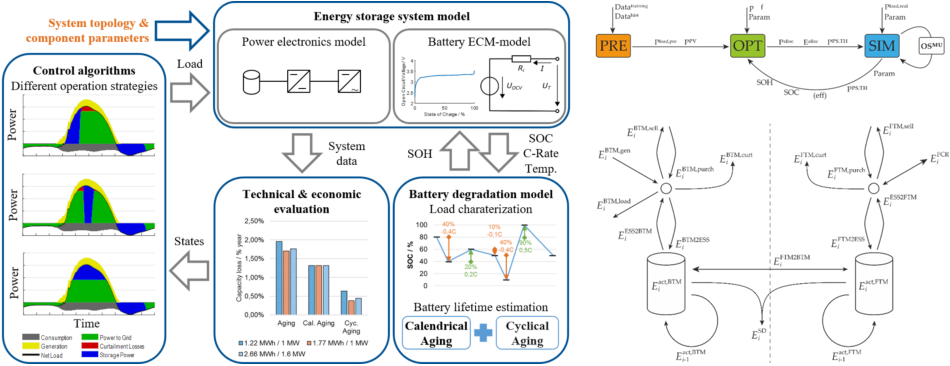Simulation and optimization toolchain

SimSES allows to conduct time-series simulations for energy storage systems in an application-specific context. The focus lies on detailed modeling of all relevant components of a storage system to monitor the state evolution (e.g. state of charge, state of health) in a predefined applicational context. Through a series of integrated technical and economic analysis features, the user may derive and observe system parameters and key performance indicators, e.g. storage degradation (aging), dissipation losses (efficiency), net present value generation, etc. SimSES can work stand-alone or can be coupled to external programs defining the dispatch strategy for the storage system, e.g. the optimization tools presented on this page.
The optimization tools lp_opt, 3D_milp, and mu_opt have been developed to optimally control the energy management system (EMS) of lithium-ion battery storage in either singular or multiple use cases to be served simultaneously. More details about their specific features and aims can be found in the specific enlargement tabs.
Tools

Highlights & Features:
- Time series analysis tool for detailed technical and economical evaluation of stationary storage systems
- Degradation of stationery and vehicle storage system
- Modelling of batteries, redox-flow systems and PTG systems
- Modelling of DC/DC and AC/DC converters
- Thermal Modelling
Applications:
- Frequency Regulation
- Peak-Shaving
- Power Boost
- Self-Consumption Increase
- Vehicle-to-Grid
Code:

Highlights & Features:
- Co-optimization of stationery and vehicle storage's operation strategy
- Multi-storage optimization for residential power flow model
- Minimization of operating expenses in form of electricity costs
- Maximization of self-consumption and self-sufficiency
- Considering various technical components of residential entity
- Uni-directional and bi-directional charging schemes of electric vehicle
- Considering varying vehicle usage patterns
Applications:
- Multi-Storage
- Self-Consumption Increase
- Vehicle-to-Grid
Code:
How to cite:

Highlights & Features:
- Dynamic allocation of energy and power of energy storage system
- Segmentation into virtual energy and power partitions
- Behind-the-meter and in-front-the-meter applications
- Mixed-integer linear programming + rolling-horizon optimization
- Linearization of non-linear internal processes
- Degradation model for well-established cell chemistry
- Consideration of market and regulatory constraints
Applications:
- Frequency Regulation
- Multi-Use
- Peak-Shaving
- Self-Consumption Increase
- Spot Market Trading
Code:
How to cite:

Highlights & Features:
- Coupling tool for SimSES and eDisGo:
- Integration of SimSES time series analysis tool for detailed technical evaluation
- Power-flow analysis with eDisGo
- Positioning of stationary battery storage systems in distribution grids
- Potential of Vehicle-2-Grid in distribution grids
- Minimization of grid reinforcement costs
Applications:
- Peak-Shaving
- Power Boost
- Vehicle-to-Grid
Code: